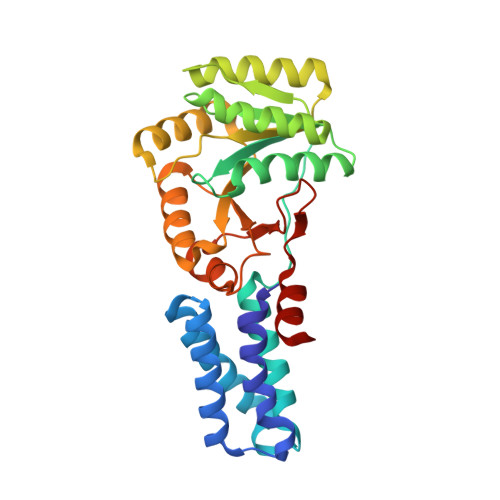The conformation of bound GMPPNP suggests a mechanism for gating the active site of the SRP GTPase.
Padmanabhan, S., Freymann, D.M.(2001) Structure 9: 859-867
- PubMed: 11566135
- DOI: https://doi.org/10.1016/s0969-2126(01)00641-4
- Primary Citation of Related Structures:
1JPJ, 1JPN - PubMed Abstract:
The signal recognition particle (SRP) is a phylogenetically conserved ribonucleoprotein that mediates cotranslational targeting of secreted and membrane proteins to the membrane. Targeting is regulated by GTP binding and hydrolysis events that require direct interaction between structurally homologous "NG" GTPase domains of the SRP signal recognition subunit and its membrane-associated receptor, SR alpha. Structures of both the apo and GDP bound NG domains of the prokaryotic SRP54 homolog, Ffh, and the prokaryotic receptor homolog, FtsY, have been determined. The structural basis for the GTP-dependent interaction between the two proteins, however, remains unknown. We report here two structures of the NG GTPase of Ffh from Thermus aquaticus bound to the nonhydrolyzable GTP analog GMPPNP. Both structures reveal an unexpected binding mode in which the beta-phosphate is kinked away from the binding site and magnesium is not bound. Binding of the GTP analog in the canonical conformation found in other GTPase structures is precluded by constriction of the phosphate binding P loop. The structural difference between the Ffh complex and other GTPases suggests a specific conformational change that must accompany movement of the nucleotide from an "inactive" to an "active" binding mode. Conserved side chains of the GTPase sequence motifs unique to the SRP subfamily may function to gate formation of the active GTP bound conformation. Exposed hydrophobic residues provide an interaction surface that may allow regulation of the GTP binding conformation, and thus activation of the GTPase, during the association of SRP with its receptor.
- Department of Molecular Pharmacology and Biological Chemistry, Northwestern University Medical School, Chicago, IL 60611, USA.
Organizational Affiliation:

















